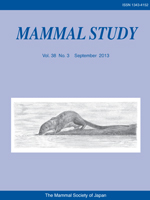The Asian house shrew (Suncus murinus) is a commensal species whose has become widespread across the Old World due to human activities. This species has been well studied in captivity as a laboratory animal; however, in the wild, its ecological habits are not well investigated. We conducted radio-telemetry surveys to determine home range, habitat selection, and activity patterns of the Asian house shrew over 1 week in September 2012 on Okinawa-jima Island, Japan. The home range size of male shrews was 2,556 m2 on average. The shrews were nocturnal, and they exhibited repetitive cycles of active and inactive during the night. The shrews did not move from dens during the daytime, although a few brief activities were observed near dens. Shrews favored grassland habitat as a nocturnal activity place (presumable foraging sites), whereas they favored under floors of artificial constructions as den sites. Our results suggest that Asian house shrews live in near human residential area to obtain the favorable den sites, and they do not absolutely need food resources from human activities for their settlement.
How to translate text using browser tools
1 September 2013
Home Range, Habitat Selection, and Activity of Male Asian House Shrews, Suncus murinus, on Okinawa-Jima Island
Atsushi Nakamoto,
Nozomi Nakanishi
ACCESS THE FULL ARTICLE

Mammal Study
Vol. 38 • No. 3
September 2013
Vol. 38 • No. 3
September 2013
activity pattern
home range size
human activities
radio-tracking
Ryukyu Archipelago




